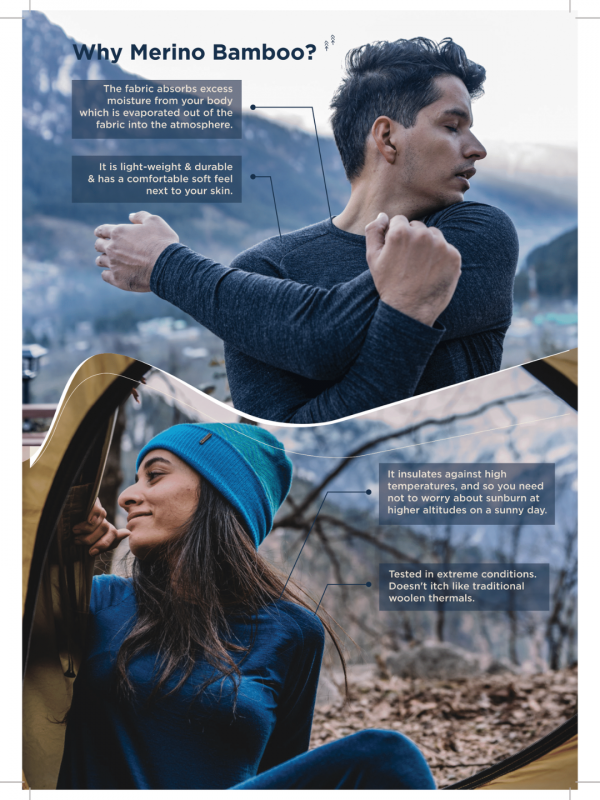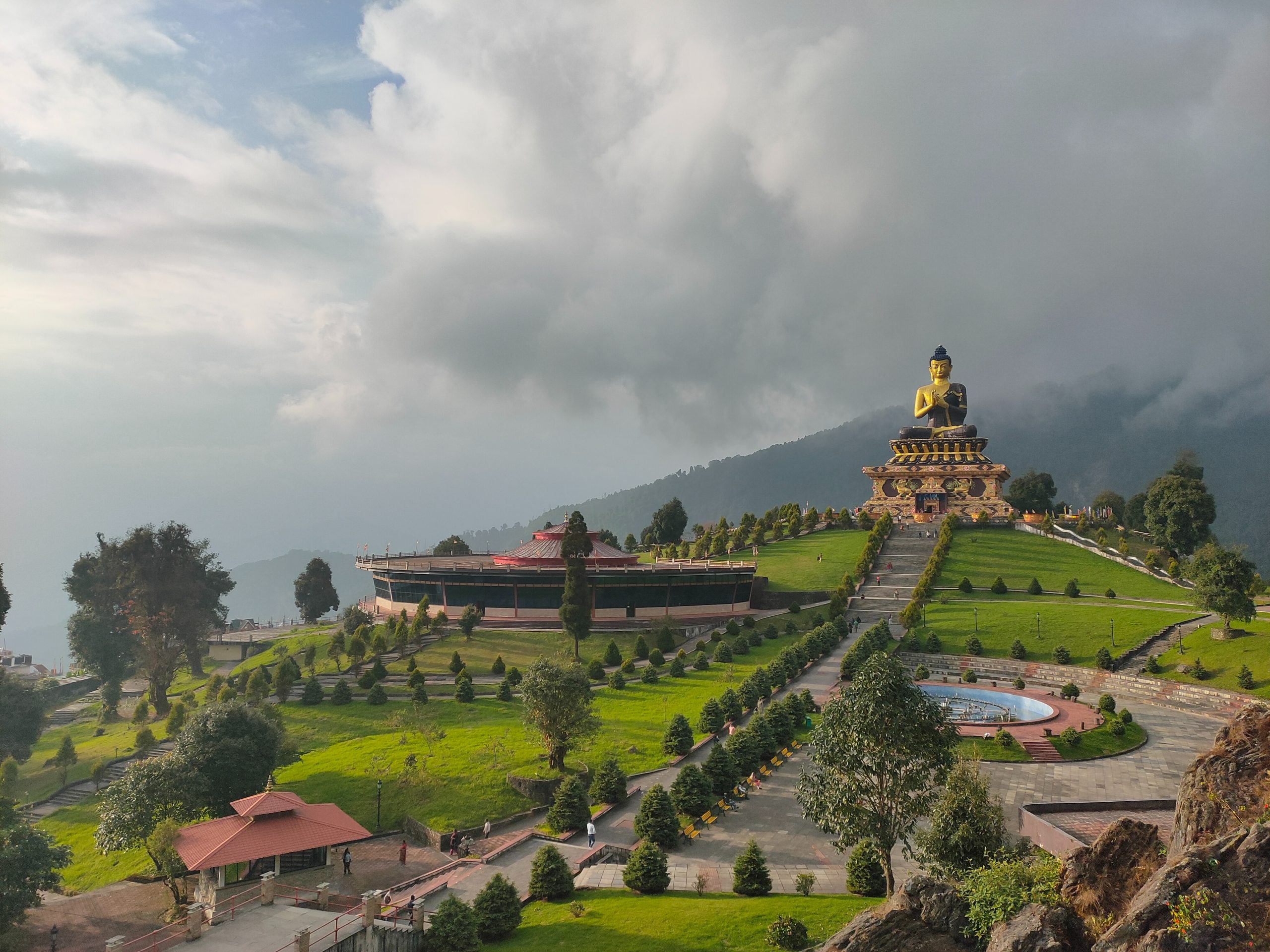
Nestled in the northeastern part of India, Sikkim transforms into a mesmerizing winter wonderland when the colder months set in. With its dramatic landscapes and pristine natural beauty, Sikkim has become an enchanting destination for winter travelers. The state is adorned with snow-capped peaks, frozen lakes, and dense forests, creating a picture-perfect setting for those seeking a unique cold-weather experience. From winter sports and treks through snow-covered trails to cultural festivals and serene monasteries, Sikkim in winter offers a diverse range of activities to make your getaway truly memorable.
When embarking on a winter adventure in a place like Sikkim, having the right apparel is essential not just for comfort but also for environmental responsibility. Sustainable travel apparel plays a crucial role in ensuring that you stay warm, dry, and comfortable in cold weather while minimizing your impact on the environment. Brands like Kosha offer eco-friendly clothing options designed to withstand the rigors of winter travel. These apparel choices prioritize sustainability through the use of recycled materials, responsible manufacturing processes, and durable designs. (https://www.iport.com/) By choosing sustainable travel apparel, you can enjoy Sikkim’s winter beauty while treading lightly on the planet.
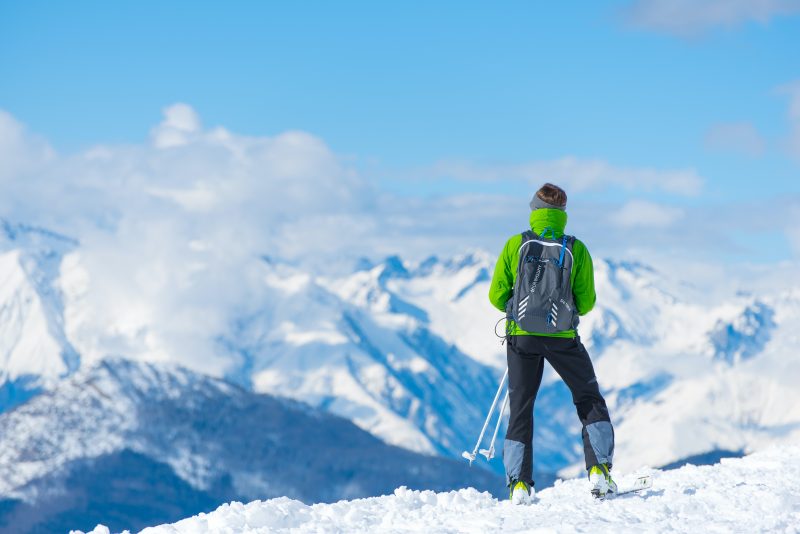
Trekking in Sikkim
Sikkim in Winter: Weather and Climate
Sikkim experiences a diverse range of climates due to its varying altitudes, but in winter, the entire state is characterized by cold temperatures and occasional snowfall. Here’s a breakdown of Sikkim’s winter climate:
- Lowlands (Terai Region): The lower altitudes, such as Siliguri and Gangtok, have milder winters with temperatures ranging from 7°C to 15°C (45°F to 59°F). Snowfall is rare in these areas.
- Midlands: Towns like Kalimpong and Pelling, situated at medium elevations, experience cooler temperatures ranging from 2°C to 10°C (36°F to 50°F) in winter. Snowfall is possible but not frequent.
- Highlands: The high-altitude regions, including places like Lachung, Lachen, and Gurudongmar Lake, have frigid winters with temperatures often dropping below freezing, ranging from -5°C to 5°C (23°F to 41°F). Snowfall is common, and roads may be covered in snow and ice.
- East Sikkim: Gangtok, the capital, sees temperatures between 2°C to 10°C (36°F to 50°F) in winter, with occasional snowfall.
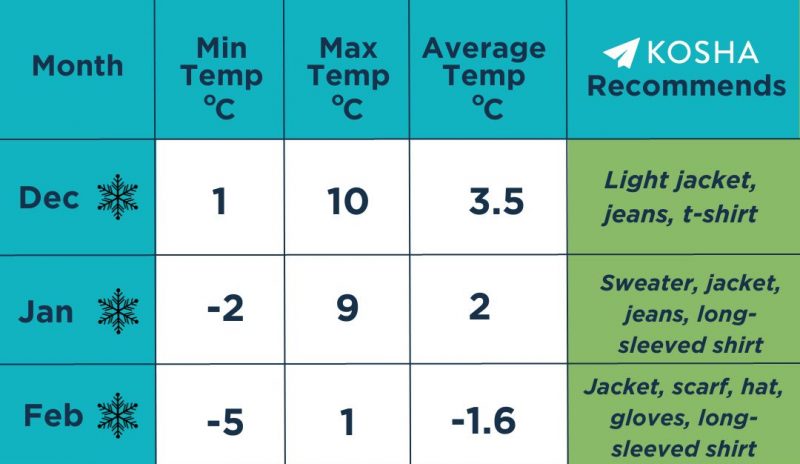
Average Temperature in Sikkim in Winter
Packing Considerations for Sikkim in Winter
Packing for a winter trip to Sikkim requires careful consideration of the climate and the activities you plan to undertake. Here are some essential items to pack:
- Warm Clothing: Layering is key. Pack thermal innerwear, insulated jackets, sweaters, and a waterproof, insulated outer layer. Ensure your clothing is breathable and moisture-wicking.
- Accessories: Don’t forget gloves, a warm hat, a scarf, and earmuffs to protect your extremities from cold winds.
- Footwear: Insulated, waterproof boots with good traction are essential, especially if you plan to trek or explore snowy areas.
- Socks: Woolen or thermal socks are crucial to keep your feet warm and dry.
- Travel-friendly Sustainability: Opt for sustainable travel apparel from brands like Kosha, which offers eco-friendly and responsibly manufactured clothing. Look for insulated, moisture-wicking, and lightweight options.
- Backpack: A sturdy, weather-resistant backpack is essential for carrying essentials during your outings.
- Electronics: Cold weather can affect battery life, so bring portable chargers for your devices.
- Medications and First Aid: Cold weather can exacerbate health issues. Pack any necessary medications and a basic first-aid kit.
- Snacks: High-energy snacks and a thermos with hot beverages can provide comfort during outdoor activities.
- Travel Documents: Ensure you have all required documents, including permits, and store them in a waterproof pouch.
- Winter Accessories: Sunglasses with UV protection, lip balm, and sunscreen are important to protect against the sun’s reflection on the snow.
- Camera and Gear: If you’re a photographer, bring the appropriate gear, including cold-resistant camera equipment.
By packing smartly and with an emphasis on sustainability, you can enjoy Sikkim in winter beauty comfortably and responsibly.
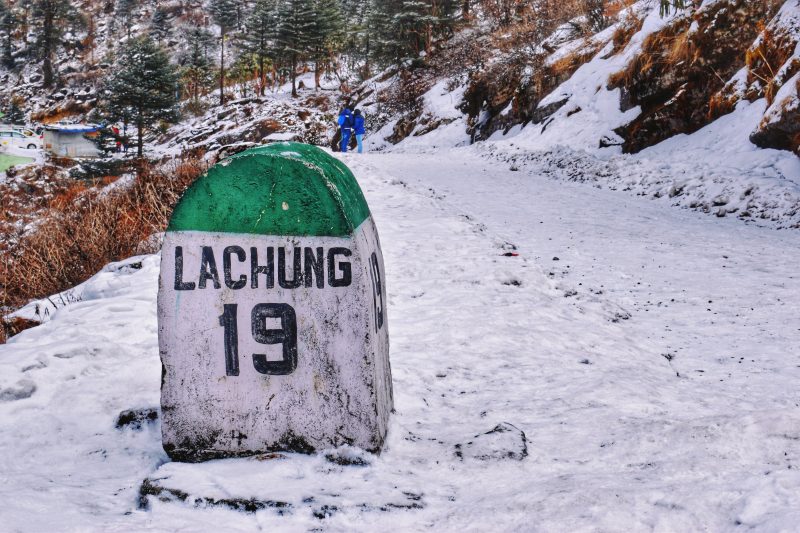
Lachung in Sikkim
Wearing Sustainable Technical Apparel
Eco-friendly travel clothing offers a range of advantages for environmentally-conscious travelers, especially in the context of winter trips to destinations like Sikkim:
- Sustainability: Sustainable travel clothing is typically made from eco-friendly materials like organic cotton, recycled polyester, and sustainable fabrics. This reduces the environmental impact of clothing production.
- Durability: Eco-friendly clothing tends to be well-constructed and durable, ensuring it can withstand the rigors of travel, including winter conditions in places like Sikkim.
- Comfort: These clothing options are designed for comfort, with moisture-wicking properties, breathability, and insulation to keep you warm in cold weather.
- Versatility: Many sustainable clothing pieces are versatile, allowing you to pack lighter as they can be layered or mixed and matched for various outfits.
- Reduced Chemicals: Eco-friendly clothing often avoids harmful chemicals and dyes, making them safer for both wearers and the environment.
Introduction to Kosha’s Sustainable Winter Gear:
Kosha, an innovative brand in the realm of sustainable technical travel apparel, offers a range of winter gear designed to enhance your winter travel experiences, including those in Sikkim. Here’s an introduction to Kosha’s sustainable winter gear:
- Eco-friendly Materials: Kosha’s winter clothing is crafted using sustainable materials that reduce environmental impact.
- Insulation and Warmth: Kosha’s winter gear provides optimal insulation and warmth without compromising sustainability or comfort.
- Moisture Management: Their clothing is designed to wick away moisture and regulate body temperature, crucial for comfort in varying winter conditions.
- Layering Options: Kosha offers a variety of layering options, allowing you to adapt to changing weather conditions.
- Sustainability Commitment: Kosha is dedicated to responsible and eco-friendly manufacturing processes, ensuring their products align with your sustainable travel values.
- Durability: Kosha’s clothing is built to last, making it suitable for multiple winter trips and adventures.
Winter Activities in Sikkim
Trekking Through Snow-Covered Trails in Sikkim in Winter:
Sikkim offers a plethora of trekking opportunities amidst its snow-covered landscapes during the winter season. Here’s what you need to know:
- Goecha La Trek: This challenging trek takes you to the Goecha La pass with breathtaking views of Kanchenjunga, the world’s third-highest peak. Snow-covered trails add an extra layer of adventure and beauty.
- Dzongri Trek: A shorter alternative to Goecha La, the Dzongri trek is equally stunning in winter, offering panoramic views of snow-clad peaks.
- Kupup Lake Trek: A relatively easy trek leading to the frozen Kupup Lake, it’s perfect for those seeking a serene winter trek.
- Winter Gear: Trekking in winter requires specialized gear, including insulated boots, warm clothing, and accessories. Kosha’s sustainable technical travel apparel includes insulated options designed to keep you warm while being eco-friendly.
Winter Sports and Adventure Activities in Sikkim in Winter:
Sikkim transforms into an adventure lover’s paradise in winter with a range of thrilling activities:
- Skiing and Snowboarding: Head to the slopes in areas like Yumthang Valley and Lachung for some skiing and snowboarding action. Lessons are available for beginners.
- Ice Skating: Try your hand at ice skating on frozen lakes like Tsomgo Lake or ice rinks in Gangtok.
- Snowshoeing: Explore the snowy terrain on snowshoes, a great way to access areas that are otherwise difficult to reach.
- Paragliding: Sikkim’s paragliding spots offer an entirely different experience in winter with crisp, clear skies and breathtaking views.
- River Rafting: For the more daring, winter river rafting in Teesta River is an adrenaline-pumping activity.
Birdwatching and Wildlife Spotting in Sikkim in Winter:
Sikkim’s diverse landscapes make it a haven for birdwatchers and wildlife enthusiasts even in the winter months:
- Birdwatching: Sikkim is home to various bird species, including colorful Himalayan monals and crimson sunbirds. Visit the Kyongnosla Alpine Sanctuary or Maenam Wildlife Sanctuary for birdwatching.
- Red Panda Spotting: While elusive, red pandas can be spotted in forests like Singalila National Park during winter.
- Yak Safari: Experience wildlife up close with a yak safari in the higher altitudes. Yaks are well-suited to snowy terrains and provide a unique way to explore.
Remember to dress warmly and in layers, including sustainable technical travel apparel from Kosha, which can provide the insulation and moisture-wicking properties necessary for these outdoor adventures in Sikkim’s winter wonderland.
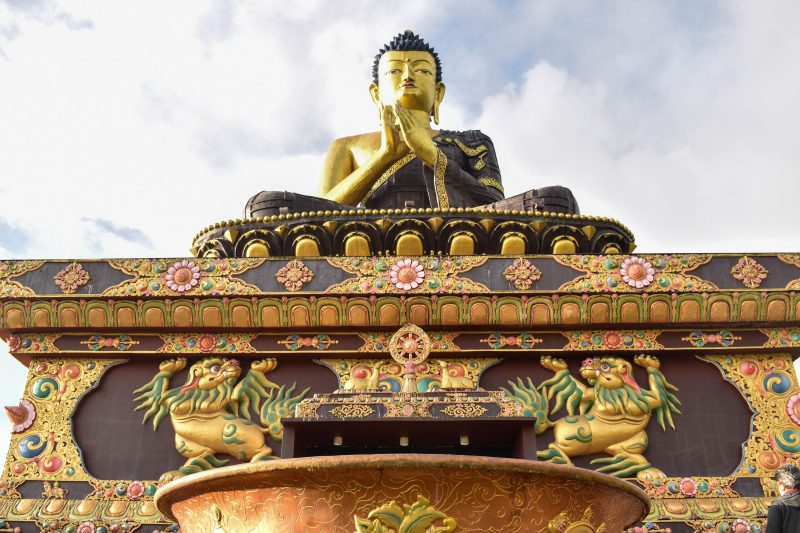
Monastries for praying in Sikkim
Visit Monasteries and Temples
The Serene Ambiance of Sikkim’s Monastic Centers:
Sikkim is renowned for its monastic centers that offer a tranquil escape in the winter months. Here’s what you can expect:
- Rumtek Monastery: One of the most prominent monasteries in Sikkim, Rumtek Monastery, is a serene retreat with its glistening stupas and peaceful surroundings. Winter brings a sense of quiet contemplation, making it an ideal time for meditation.
- Pemayangtse Monastery: Nestled amidst the snow-capped peaks, Pemayangtse Monastery exudes an otherworldly charm in winter. The serene ambiance makes it an excellent place to connect with your spiritual side.
- Tashiding Monastery: Perched atop a hill, Tashiding Monastery offers panoramic views of the snow-covered Himalayas. It’s a place of solace and reflection, perfect for a winter visit.
Participating in Winter Festivals and Rituals of Sikkim in Winter:
Sikkim’s rich cultural heritage is brought to life through its winter festivals and rituals. Here are some you can participate in:
- Losar Festival: Celebrated to mark the Tibetan New Year, Losar is a vibrant festival with colorful processions, traditional dances, and rituals. Join the locals in welcoming the New Year with joyous festivities.
- Maghe Sankranti: Observed in January, this festival celebrates the winter harvest with special rituals and feasts. You can partake in traditional Sikkimese dishes during this time.
- Tongnam: A unique winter festival celebrated by the Lepcha community, Tongnam involves prayers, dances, and cultural performances. It’s a wonderful opportunity to learn about Sikkim’s indigenous cultures.
- Cham Dances: Many monasteries perform Cham dances during winter festivals. These intricate masked dances depict stories from Buddhist mythology and are a mesmerizing cultural experience.
- Butter Lamp Festival: Held in monasteries like Enchey and Pemayangtse, this festival involves lighting thousands of butter lamps, creating a mystical ambiance.
When participating in these festivals and rituals, it’s essential to respect local customs and traditions. Embrace the winter spirit of Sikkim and immerse yourself in the cultural richness of the region. Don’t forget to dress warmly in sustainable technical travel apparel from Kosha to stay comfortable during these outdoor cultural celebrations in the cold.
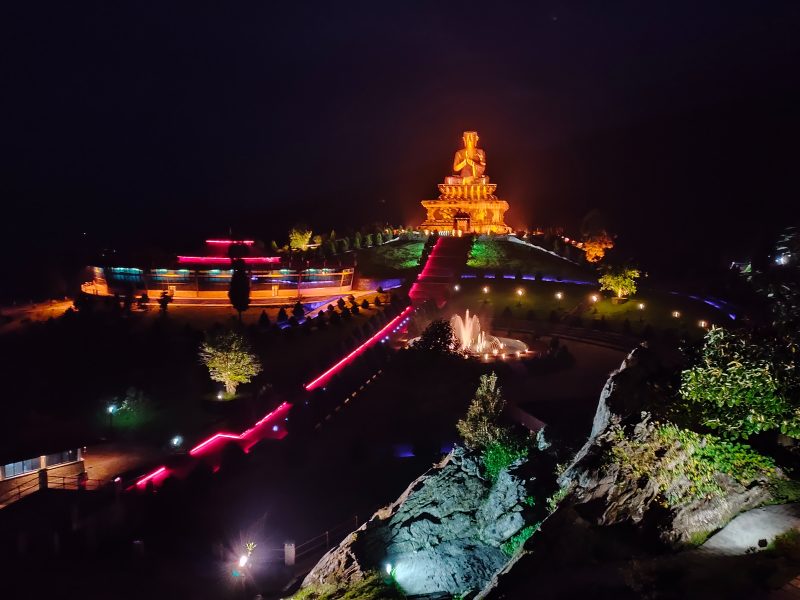
Butter lamp festival in Sikkim
Sampling Sikkimese Cuisine
Delicious Winter Dishes and Traditional Fare:
Sikkim’s cuisine takes on a warm and hearty character in the winter months, featuring dishes that provide comfort and sustenance in the cold. Here are some delicious winter dishes and traditional fare to savor:
- Thukpa: A piping hot noodle soup, Thukpa is a winter favorite. It’s made with a flavorful broth, vegetables, and sometimes meat, offering warmth and nourishment.
- Phagshapa: This hearty pork stew is slow-cooked with radishes, dried chilies, and fermented bamboo shoots, creating a rich and flavorful dish.
- Sel Roti: A traditional Sikkimese rice-based donut, Sel Roti is deep-fried to perfection, offering a warm and crunchy treat.
- Sha Phaley: These savory stuffed bread pockets are a popular snack, filled with seasoned meat or vegetables and fried until golden brown.
- Chhurpi Soup: Made from fermented cheese, Chhurpi soup is a warm and wholesome dish, often served with rice or bread.
- Bamboo Shoot Curry: Bamboo shoots are a winter delicacy in Sikkim, and they are prepared in various ways, including curries and pickles.
Local Markets and Eateries to Explore:
Exploring local markets and eateries is an integral part of experiencing Sikkim’s culinary delights. Here are some places to visit in winter:
- MG Marg, Gangtok: This popular street is lined with a variety of restaurants and street food vendors serving both local and international cuisine. Try some local winter specialties here.
- Kiosk at Tsomgo Lake: While visiting Tsomgo Lake, don’t miss the opportunity to try piping hot Maggi noodles, a comforting snack in the cold.
- M.G. Road Winter Market: In winter, this market comes alive with vendors selling winter wear, local handicrafts, and, of course, delicious hot snacks.
- Local Homestays: Staying in a homestay during winter allows you to savor authentic Sikkimese dishes prepared by local families. They often use fresh ingredients from their gardens.
- Traditional Sikkimese Restaurants: Seek out traditional Sikkimese restaurants like “The Square” in Gangtok or “Hotel Newa” in Pelling for a taste of authentic local cuisine.
Winter in Sikkim is not only a visual delight but also a culinary adventure. Exploring local markets and eateries to savor these warming dishes is an essential part of the winter experience.

Local markets in Sikkim
Hot Springs and Wellness Retreats
Soothing Your Senses in Natural Hot Springs in Sikkim in Winter
Sikkim’s natural hot springs, known as “Tso Pema” in the local language, are the perfect places to unwind and find respite from the winter chill. Here’s what you can expect:
- Yumthang Hot Springs: Located in the Yumthang Valley, these hot springs offer a surreal experience amidst snow-covered landscapes. The mineral-rich waters are believed to have therapeutic properties, making them perfect for soothing tired muscles and relaxing in the cold.
- Ralong Hot Springs: Nestled near Ravangla, the Ralong Hot Springs is set in a tranquil environment with lush greenery and a serene ambiance. Soaking in these natural pools is a rejuvenating experience, especially during the winter months.
- Yumey Samdong Hot Springs: These hidden gems are located near Lachung and require a trek to access them. The effort is well worth it as you can enjoy the warmth of the hot springs while surrounded by pristine snow.
Wellness and Rejuvenation in Sikkim’s Resorts
Sikkim boasts numerous resorts and wellness centers that offer a range of treatments and services to rejuvenate both body and mind during the winter season:
- Mayfair Spa Resort, Gangtok: This luxury resort offers spa treatments, yoga sessions, and wellness packages that provide much-needed relaxation in a serene mountain setting.
- Elgin Mount Pandim, Pelling: Nestled amidst the Himalayas, this heritage hotel offers rejuvenating spa therapies, yoga, and meditation to help you de-stress in a winter wonderland.
- The Norbu Ghang Retreat and Spa, Yuksom: A boutique resort in Yuksom, this place offers traditional Sikkimese healing therapies and a tranquil atmosphere for holistic wellness.
- Temi Tea Garden Resort, Temi: Surrounded by tea gardens, this resort is an ideal place to unwind with nature walks, spa treatments, and tea-tasting sessions.
- Chumbi Mountain Retreat, Pelling: Enjoy the serene ambiance of this mountain retreat while indulging in spa treatments and yoga sessions to revitalize your senses.
Whether you choose to soak in natural hot springs or rejuvenate in wellness resorts, Sikkim offers the perfect setting for relaxation and wellness during the winter months.
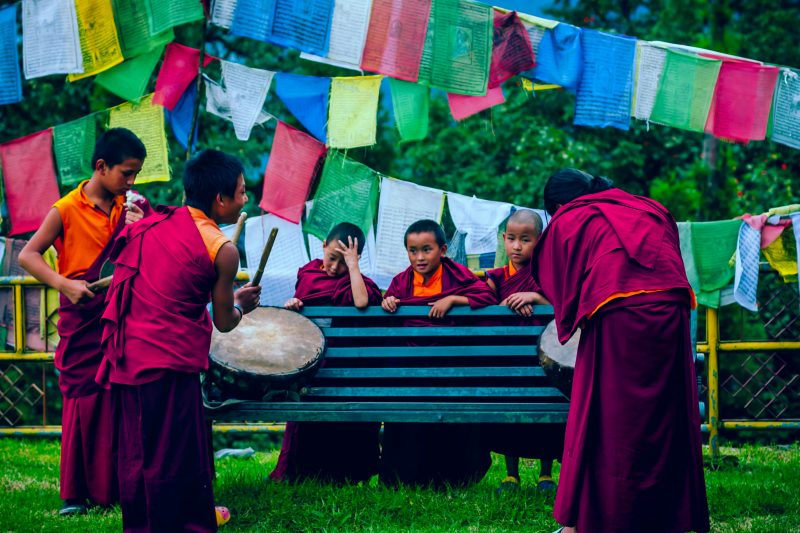
Peaceful stay in Monastries
Safety and Health Considerations
Staying Warm and Safe in Sikkim’s Winter:
Sikkim’s winter can be charming, but it’s essential to stay warm and safe, especially if you’re venturing into high-altitude areas. Here are some tips:
- Layering: Dress in layers with sustainable technical travel apparel from Kosha to ensure warmth and moisture-wicking. Start with thermal innerwear, add insulating layers, and finish with a waterproof and windproof outer layer.
- Footwear: Wear insulated, waterproof boots with good traction for slippery and snowy terrain. Woolen or thermal socks are essential.
- Accessories: Don’t forget a warm hat, gloves, a scarf, and earmuffs to protect your extremities from cold winds.
- Stay Hydrated: Drink plenty of fluids to stay hydrated, but avoid consuming alcohol, as it can contribute to dehydration.
- Altitude Considerations: Be aware of altitude-related challenges and acclimatize properly. Symptoms of altitude sickness can include headache, nausea, and fatigue. If you experience these symptoms, descend to a lower altitude.
- Safety Gear: If you’re embarking on winter sports or treks, consider safety gear such as helmets and crampons.
- Local Advice: Seek advice from local guides and residents about current weather conditions and safety concerns in the area.
- Communication: Carry a charged phone with local SIM cards or a satellite phone for emergency communication.
- Emergency Kit: Bring a basic first-aid kit and any necessary medications, especially for altitude sickness. Also, carry a flashlight, whistle, and multi-tool.
- Travel Insurance: Ensure you have comprehensive travel insurance that covers medical emergencies, evacuation, and trip cancellations.
- Road Safety: If you’re driving in winter conditions, ensure your vehicle is equipped with snow chains, and drive cautiously on icy roads.
- Respect Nature: Respect the environment and follow Leave No Trace principles. Avoid disturbing wildlife and adhere to park regulations.
By taking these precautions and staying warm, you can have a safe and enjoyable winter experience in Sikkim. It’s essential to prioritize your safety, comfort, and well-being during your winter adventures in this stunning region.
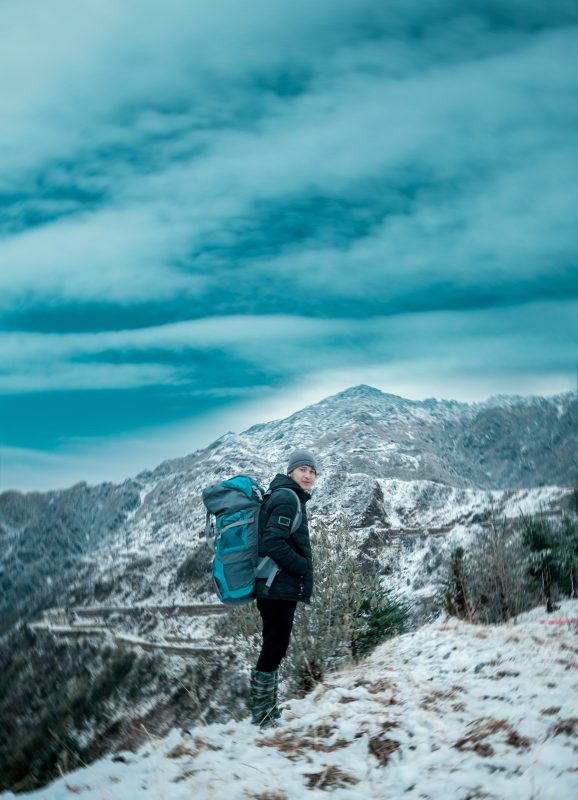
Trekking in Sikkim
Importance of traditional attire and layering
Traditional attire and layering play a significant role in keeping warm and comfortable during the winter months in Sikkim. Here’s why they are essential:
- Cultural Respect: Embracing the traditional attire of Sikkim not only adds to your experience but also shows respect for the local culture. It’s an excellent way to connect with the people and traditions of the region.
- Insulation: Traditional Sikkimese clothing is often designed for the specific demands of the local climate. These garments typically use thick, warm materials that provide excellent insulation against the cold.
- Layering for Versatility: Layering is a practical approach to dressing in cold weather. Traditional attire often includes several layers that can be added or removed as needed to regulate your body temperature.
- Moisture Management: Layering allows you to incorporate moisture-wicking materials close to your skin, keeping you dry even if you perspire during activities like trekking.
- Adaptability: The weather in Sikkim can change quickly, especially as you move to different altitudes. Layering with traditional clothing makes it easier to adapt to these changes by adding or removing layers as required.
- Protection Against the Elements: Traditional attire may include outer garments like shawls or coats that protect against cold winds and snowfall.
- Comfort and Style: Traditional attire can be both comfortable and stylish. Many travelers find these garments to be not only functional but also visually appealing.
- Enhanced Cultural Experience: By wearing traditional attire, you may be more readily welcomed into local ceremonies and events, enhancing your overall cultural experience.
- Preservation of Heritage: Supporting and wearing traditional clothing can contribute to the preservation of local heritage and craftsmanship.
While traditional attire can be a valuable addition to your winter wardrobe in Sikkim, it’s also important to incorporate modern layering techniques, especially when participating in outdoor activities or exploring diverse altitudes. Sustainable technical travel apparel, like those offered by brands like Kosha, can complement traditional clothing, providing the necessary warmth, moisture-wicking properties, and adaptability required for a comfortable and enjoyable winter adventure in Sikkim.
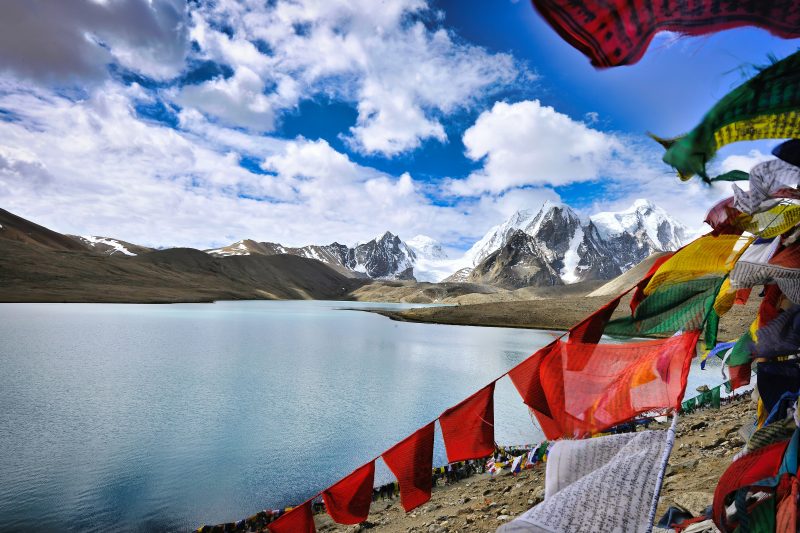
Sikkim in winter
FAQs
Here are some frequently asked questions (FAQs) about visiting Sikkim in winter.
Is it safe to visit Sikkim in winter?
Yes, it can be safe to visit Sikkim in winter if you take appropriate precautions. Be prepared for cold weather, follow local advice, and acclimatize properly, especially if you plan to trek to higher altitudes.
Are roads accessible in Sikkim during winter?
While major roads are usually kept open, some remote areas may become inaccessible due to heavy snowfall. It’s essential to check road conditions and travel with experienced drivers, especially in mountainous regions.
What should I pack for a winter trip to Sikkim?
Pack warm clothing, including thermal wear, insulated jackets, gloves, scarves, and waterproof boots. Don’t forget to include sustainable technical travel apparel for layering and moisture-wicking.
Is altitude sickness a concern in Sikkim’s winter?
Altitude sickness can be a concern when visiting high-altitude areas in Sikkim, especially in winter. It’s essential to acclimatize properly, stay hydrated, and be aware of the symptoms of altitude sickness.
Can I go trekking in Sikkim in winter?
Yes, you can go trekking in Sikkim in winter, but it’s important to choose your treks wisely, be prepared for cold weather, and have appropriate gear. Some treks, like Goecha La and Dzongri, are popular in winter.
Conclusion
As winter descends upon the enchanting landscapes of Sikkim, a world of wonder and adventure awaits those who dare to embark on this cold-weather journey. From snow-covered peaks to serene monastic centers and cultural celebrations, Sikkim in winter offers a unique and unforgettable experience.
In this comprehensive guide, we’ve delved into the myriad of activities that define a winter escapade in Sikkim. You’ve discovered the thrill of trekking through snow-clad trails, the excitement of winter sports, and the tranquility of birdwatching and wildlife spotting amidst pristine landscapes. Sikkim’s winter is not just about outdoor adventures; it’s also a time for cultural immersion. For winter clothing visit our Kosha store or website.
Sikkim in winter is a magical time when the mountains glisten with snow, and the air is filled with a sense of serenity and celebration. It’s a destination that combines natural beauty, cultural richness, and outdoor adventure to create memories that will last a lifetime. So, bundle up, embrace the cold, and embark on an extraordinary winter journey in the heart of the Himalayas, for Sikkim’s winter wonderland awaits your exploration.
This post is written by a Kosha member – Neeti Kapoor.
